Estimation of Surface Water Runoff for a Semi-Arid Area Using RS and GIS-Based SCS-CN Method
Abstract
:1. Introduction
2. Materials and Methods
2.1. Description of the Study Area
2.2. Data and Software
2.3. Methodology
2.4. Soil Texture Map
2.5. Hydrologic Soil Group Map
2.6. Land Use/Land Cover
2.7. Slope Map
2.8. The Soil Conservation Service Runoff Estimation Method
2.9. Slope-Adjusted CNII
2.10. The Soil Conservation Service Unit Hydrograph
2.11. Rainfall Data
3. Results and Discussion
3.1. Rainfall Map
3.2. Land Use/Land Cover Map
3.3. The Soil Conservation Service-Curve Number Map
3.4. Potential Maximum Retention Map
3.5. The Soil Conservation Service Runoff Map
3.6. The Soil Conservation Service Storm Hydrograph
3.7. Rainfall-Runoff Correlation Analysis
4. Conclusions
Author Contributions
Funding
Acknowledgments
Conflicts of Interest
References
- Deshmukh, D.S.; Chaube, U.C.; Hailu, A.E.; Gudeta, D.A.; Kassa, M.T. Estimation and comparision of curve numbers based on dynamic land use land cover change, observed rainfall-runoff data and land slope. J. Hydrol. 2013, 492, 89–101. [Google Scholar] [CrossRef]
- Mishra, S.K.; Chaudhary, A.; Shrestha, R.K.; Pandey, A.; Lal, M. Experimental verification of the effect of slope and land use on SCS runoff curve number. Water Resour. Manag. 2014, 28, 3407–3416. [Google Scholar] [CrossRef]
- Zade, M.; Ray, S.S.; Dutta, S.; Panigrahy, S. Analysis of runoff pattern for all major basins of India derived using remote sensing data. Curr. Sci. 2005, 88, 1301–1305. [Google Scholar]
- USDA. Hydrology. In National Engineering Handbook; United States Department of Agriculture, Soil Conservation Service, US Government Printing Office: Washington, DC, USA, 1972. [Google Scholar]
- Pradhan, R.; Pradhan, M.P.; Ghose, M.K.; Agarwal, V.S.; Agarwal, S. Estimation of RainfallRunoff using Remote Sensing and GIS in and around Singtam, East Sikkim. Int. J. Geomat. Geosci. 2010, 1, 466–476. [Google Scholar]
- Shadeed, S.; Almasri, M. Application of GIS-based SCS-CN method in West Bank catchments, Palestine. Water Sci. Eng. 2010, 3, 1–13. [Google Scholar]
- SCS. Urban Hydrology for Small Watersheds, Technical Release No. 55 (TR-55); United States Department of Agriculture, Soil Conservation Service, US Government Printing Office: Washington, DC, USA, 1986; pp. 2–6.
- Chatterjee, C.; Jha, R.; Lohani, A.K.; Kumar, R.; Singh, R. Runoff curve number estimation for a basin using remote sensing and GIS. Asian Pac. Remote Sens. GIS J. 2001, 14, 1–7. [Google Scholar]
- Bhuyan, S.J.; Mankin, K.R.; Koelliker, J.K. Watershed–scale AMC selection for hydrologic modeling. Trans. ASAE 2003, 46, 303. [Google Scholar] [CrossRef]
- Tirkey, A.S.; Pandey, A.C.; Nathawat, M.S. Use of high-resolution satellite data, GIS and NRCS-CN technique for the estimation of rainfall-induced run-off in small catchment of Jharkhand India. Geocarto. Int. 2014, 29, 778–791. [Google Scholar] [CrossRef]
- Liu, X.; Li, J. Application of SCS model in estimation of runoff from small watershed in Loess Plateau of China. Chin. Geogr. Sci. 2008, 18, 1235–1241. [Google Scholar] [CrossRef]
- Topno, A.; Singh, A.K.; Vaishya, R.C. SCS-CN Runoff estimation for Vindhyachal region using remote sensing and GIS. Int. J. Adv. Remote Sens. GIS 2015, 4, 1214–1223. [Google Scholar] [CrossRef]
- Huang, M.; Gallichand, J.; Wang, Z.; Goulet, M. A modification to the Soil Conservation Service curve number method for steep slopes in the Loess Plateau of China. Hydrol. Process. 2006, 20, 579–589. [Google Scholar] [CrossRef]
- Hawkins, R.H.; Ward, T.; Woodward, D.E.; Van Mullem, J. Curve Number Hydrology: State of the Practice Reston; ASCE: Washington, DC, USA, 2009; p. 106. [Google Scholar]
- Shi, W.; Huang, M.; Gongadze, K.; Wu, L. A modified SCS-CN method incorporating storm duration and antecedent soil moisture estimation for runoff prediction. Water Resour. Manag. 2017, 31, 1713–1727. [Google Scholar] [CrossRef]
- Fisher, P.F.; Comber, A.J.; Wadsworth, R. Land use and land cover: Contradiction or complement. In Re-Presenting GIS; Wiley: Hoboken, NJ, USA, 2005; pp. 85–98. [Google Scholar]
- NRCS. Hydrologic Soil Groups. In National Engineering Handbook; United States Department of Agriculture, Natural Resources Conservation Science, US Government Printing Office: Washington, DC, USA, 2009. [Google Scholar]
- Chaplot, V.A.; Le Bissonnais, Y. Runoff features for interrill erosion at different rainfall intensities, slope lengths, and gradients in an agricultural loessial hillslope. Soil. Sci. Soc. Am. J. 2003, 67, 844–851. [Google Scholar] [CrossRef]
- Philip, J.R. Hillslope infiltration: Planar slopes. Water Resour. Res. 1991, 27, 109–117. [Google Scholar] [CrossRef]
- Evett, S.R.; Dutt, G.R. Length and slope effects on runoff from sodium dispersed, compacted earth microcatchments. Soil. Sci. Soc. Am. J. 1985, 49, 734–738. [Google Scholar] [CrossRef]
- Fang, H.Y.; Cai, Q.G.; Chen, H.; Li, Q.Y. Effect of rainfall regime and slope on runoff in a gullied loess region on the Loess Plateau in China. Environ. Manag. 2008, 42, 402–411. [Google Scholar] [CrossRef]
- Chaudhary, A.; Mishra, S.K.; Pandey, A. Experimental verification of effect of slope on runoff and curve numbers. J. Indian Water Res. Soc. 2013, 33, 40–46. [Google Scholar]
- Jha, R.K.; Mishra, S.K.; Pandey, A. Experimental verification of effect of slope, soil, and AMC of a fallow land on runoff curve number. J. Indian Water Res. Soc. 2014, 34, 40–47. [Google Scholar]
- Cheng, Q.; Ko, C.; Yuan, Y.; Ge, Y.; Zhang, S. GIS modeling for predicting river runoff volume in ungauged drainages in the Greater Toronto Area, Canada. Comput. Geosci. 2006, 32, 1108–1119. [Google Scholar] [CrossRef]
- Zhan, X.; Huang, M.L. ArcCN-Runoff: An ArcGIS tool for generating curve number and runoff maps. Environ. Modell. Softw. 2004, 19, 875–879. [Google Scholar] [CrossRef]
- Nayak, T.R.; Jaiswal, R.K. Rainfall-runoff modelling using satellite data and GIS for Bebas river in Madhya Pradesh. J. Inst. Eng. India 2003, 84, 47–50. [Google Scholar]
- Geena, G.B.; Ballukraya, P.N. Estimation of runoff for Red hills watershed using SCS method and GIS. Indian J. Sci. Technol. 2011, 4, 899–902. [Google Scholar]
- Gitika, T.; Ranjan, S. Estimation of surface runoff using NRCS curve number procedure in Buriganga Watershed, Assam, India-a geospatial approach. Int. Res. J. Earth Sci. 2014, 2, 1–7. [Google Scholar]
- Al Saud, M. Morphometric analysis of Wadi Aurnah drainage system, western Arabian Peninsula. Open Hydrol. J. 2009, 3, 1–10. [Google Scholar]
- Dawod, G.M.; Mirza, M.N.; Al-Ghamdi, K.A. GIS-based estimation of flood hazard impacts on road network in Makkah city, Saudi Arabia. Environ. Earth Sci. 2012, 67, 2205–2215. [Google Scholar] [CrossRef]
- Saxton, K.E.; Rawls, W.; Romberger, J.S.; Papendick, R.I. Estimating generalized soil-water characteristics from texture. Soil. Sci. Soc. Am. J. 1986, 50, 1031–1036. [Google Scholar] [CrossRef]
- Cosby, B.J.; Hornberger, G.M.; Clapp, R.B.; Ginn, T. A statistical exploration of the relationships of soil moisture characteristics to the physical properties of soils. Water Resour. Res. 1984, 20, 682–690. [Google Scholar] [CrossRef] [Green Version]
- Wang, X.; Liu, T.; Yang, W. Development of a robust runoff-prediction model by fusing the rational equation and a modified SCS-CN method. Hydrolog. Sci. J. 2012, 57, 1118–1140. [Google Scholar] [CrossRef] [Green Version]
- Mishra, S.K.; Singh, V.P. Another look at SCS-CN method. J. Hydrol. Eng. 1999, 4, 257–264. [Google Scholar] [CrossRef]
- NRCS. Estimation of Direct Runoff from Storm Rainfall. In National Engineering Handbook; United States Department of Agriculture, Natural Resources Conservation Science, US Government Printing Office: Washington, DC, USA, 2004. [Google Scholar]
- Hawkins, R.H.; Hjelmfelt, A.T., Jr.; Zevenbergen, A.W. Runoff probability, storm depth, and curve numbers. J. Irrig. Drain. E ASCE 1985, 111, 330–340. [Google Scholar] [CrossRef]
- McCuen, R.H. A Guide to Hydrologic Analysis Using SCS Methods; Prentice-Hall, Inc.: Englewood Cliffs, NJ, USA, 1982; p. 145. [Google Scholar]
- Sherman, L.K. Streamflow from rainfall by the unit-graph method. Eng. News Rec. 1932, 108, 501–505. [Google Scholar]
- SCS. Use of Storm and Watershed Characteristics in Synthetic Hydrograph Analysis and Application; United States Department of Agriculture, Soil Conservation Service, US Government Printing Office: Washington, DC, USA, 1957.
- Singh, V.P.; Corradini, C.; Melone, F. A comparison of some methods of deriving the instantaneous unit hydrograph. Hydrol. Res. 1985, 16, 1–10. [Google Scholar] [CrossRef]
- NRCS. Ponds: Planning, Design, Construction. In Agriculture Handbook No. 590; United States Department of Agriculture, Natural Resources Conservation Science, US Government Printing Office: Washington, DC, USA, 1997. [Google Scholar]
- Subyani, A.M.; Al-Amri, N.S. IDF curves and daily rainfall generation for Al-Madinah city, western Saudi Arabia. Arab. J. Geosci. 2015, 8, 11107–11119. [Google Scholar] [CrossRef]
- Viessman, W., Jr.; Lewis, G.L. Introduction to Hydrology; HarperCollins College Publishers: New York, NY, USA, 1996. [Google Scholar]
- Zhao, W.W.; Fu, B.J.; Chen, L.D.; Zhang, Q.J.; Zhang, Y.H. Effects of land-use pattern change on rainfall-runoff and runoff-sediment relations: A case study in Zichang watershed of the Loess Plateau of China. J. Environ. Sci. 2004, 16, 436–442. [Google Scholar]
- Salami, A.W.; Bilewu, S.O.; Ayanshila, A.M.; Oritola, S.F. Evaluation of synthetic unit hydrograph methods for the development of design storm hydrographs for Rivers in South-West, Nigeria. J. Am. Sci. 2009, 5, 23–32. [Google Scholar]
- Peng, D.Z.; You, J.J. Application of modified SCS model into runoff simulation. J. Water Res. Water Eng. 2006, 17, 20–24. [Google Scholar]
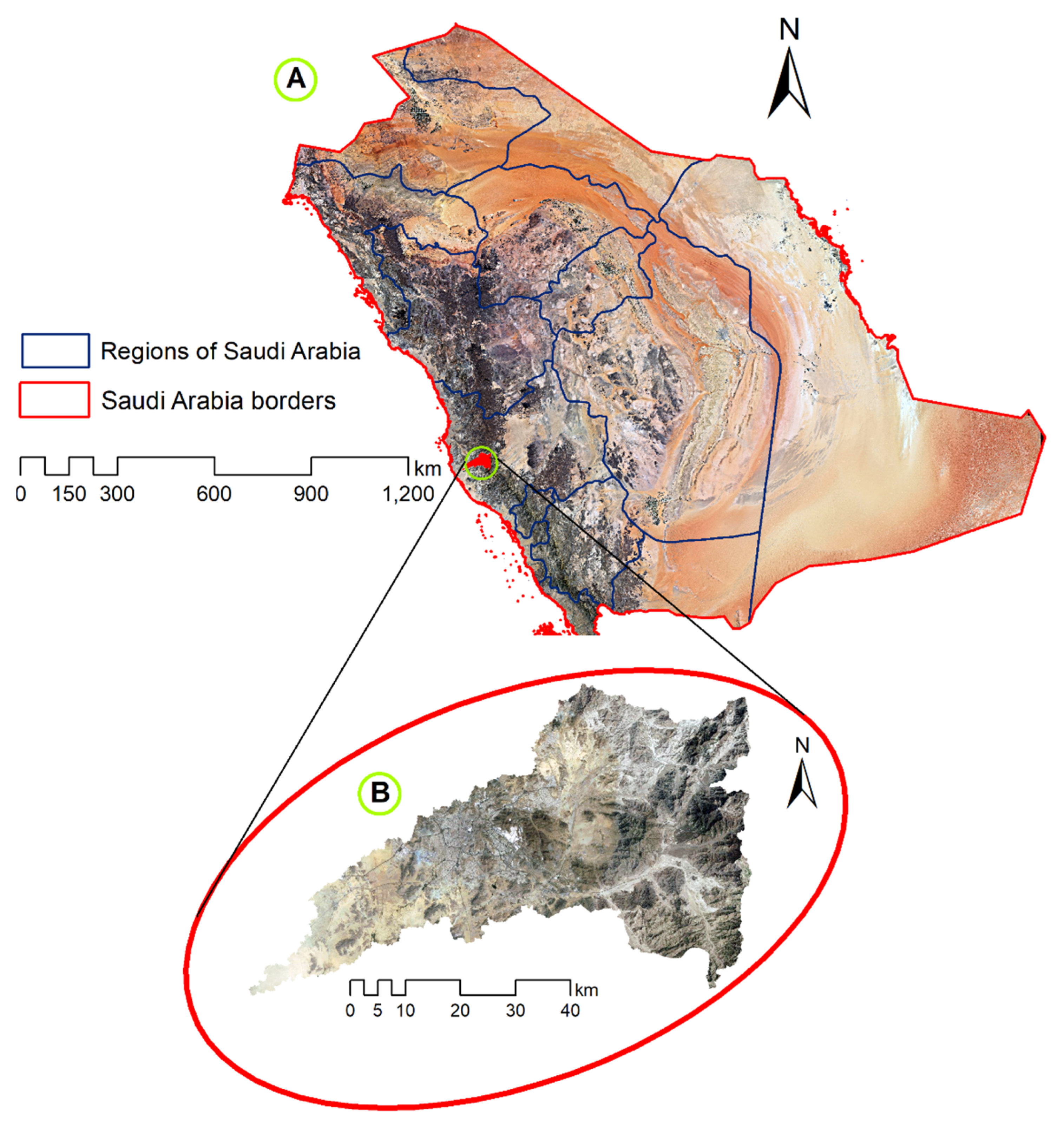

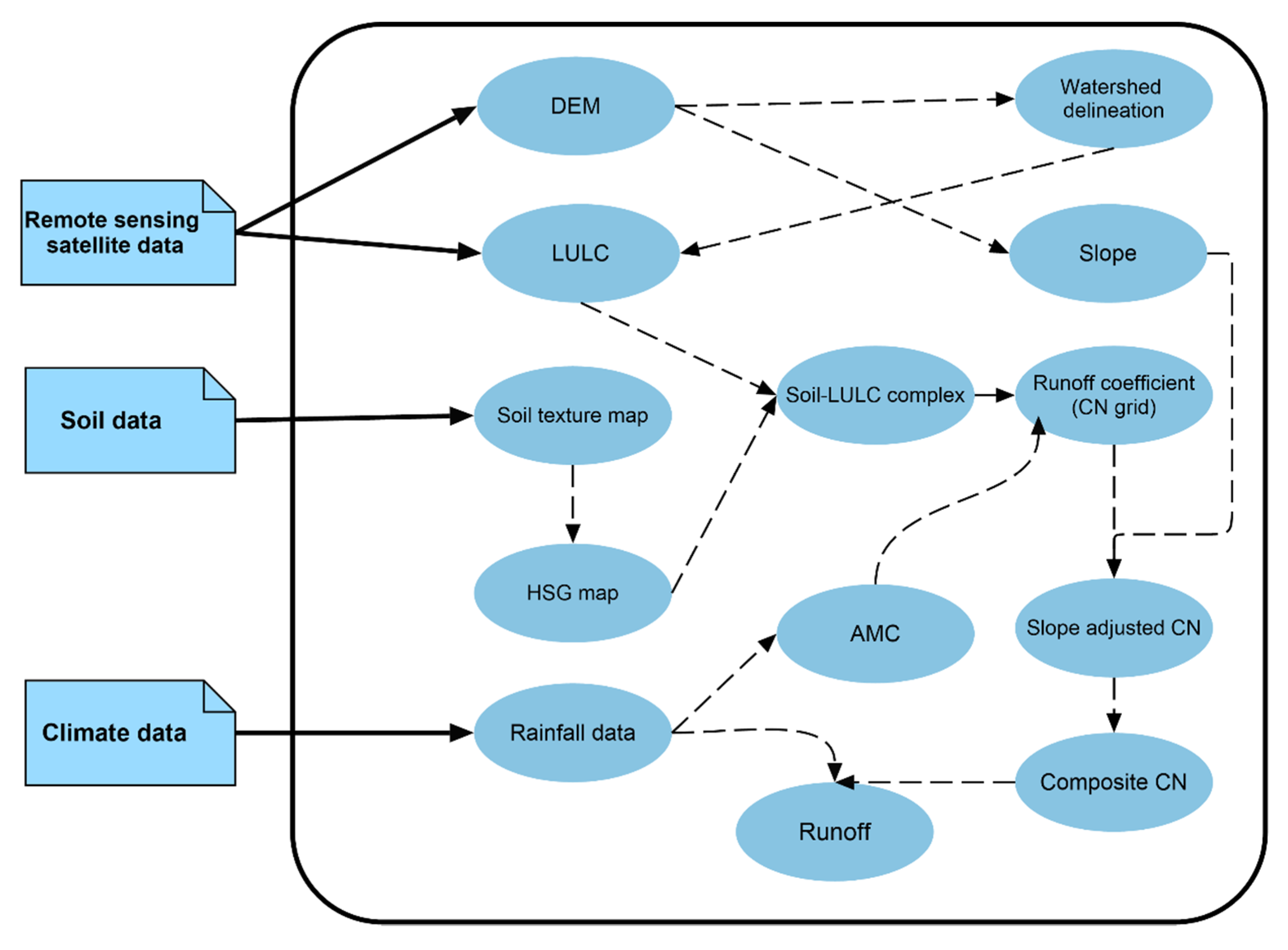
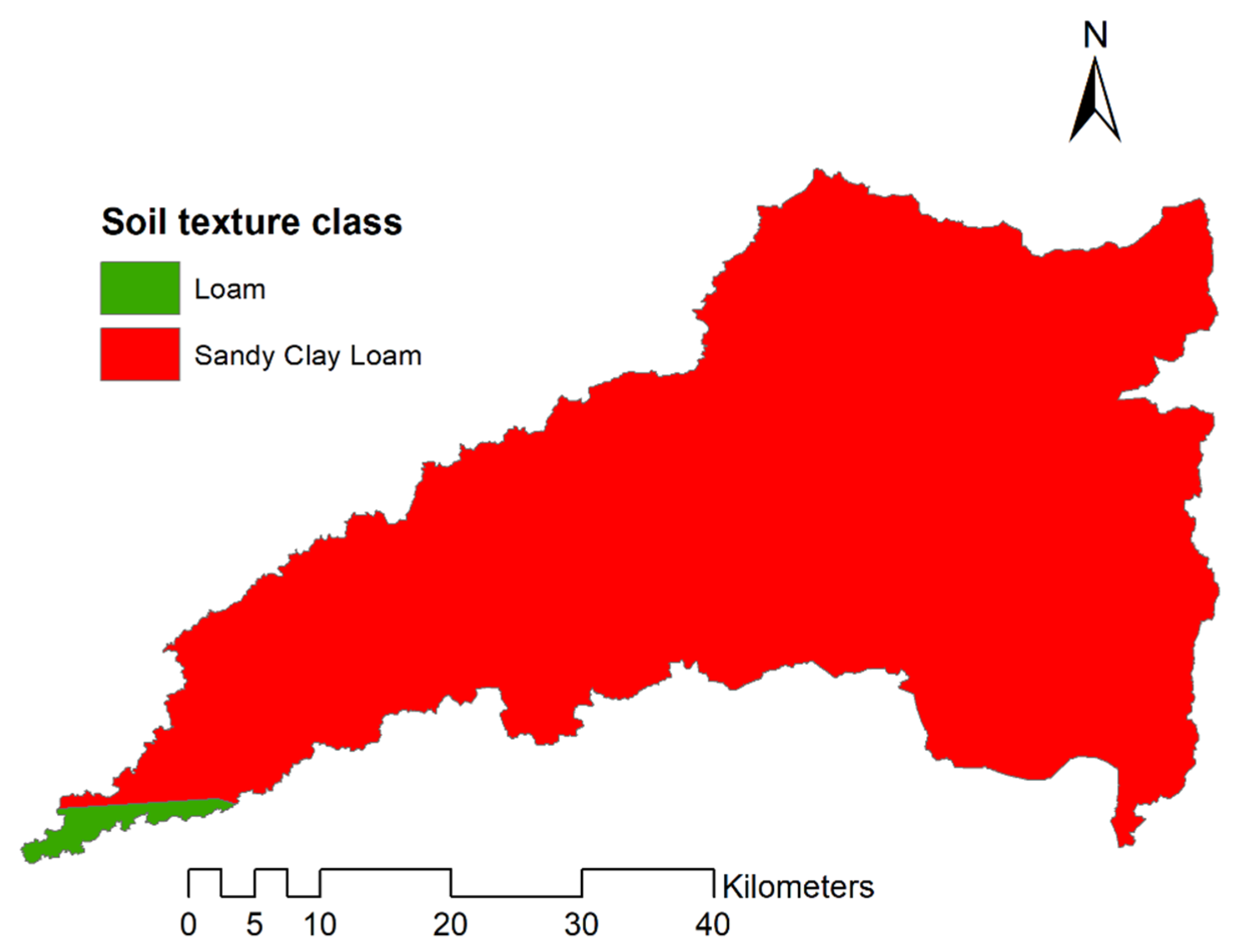

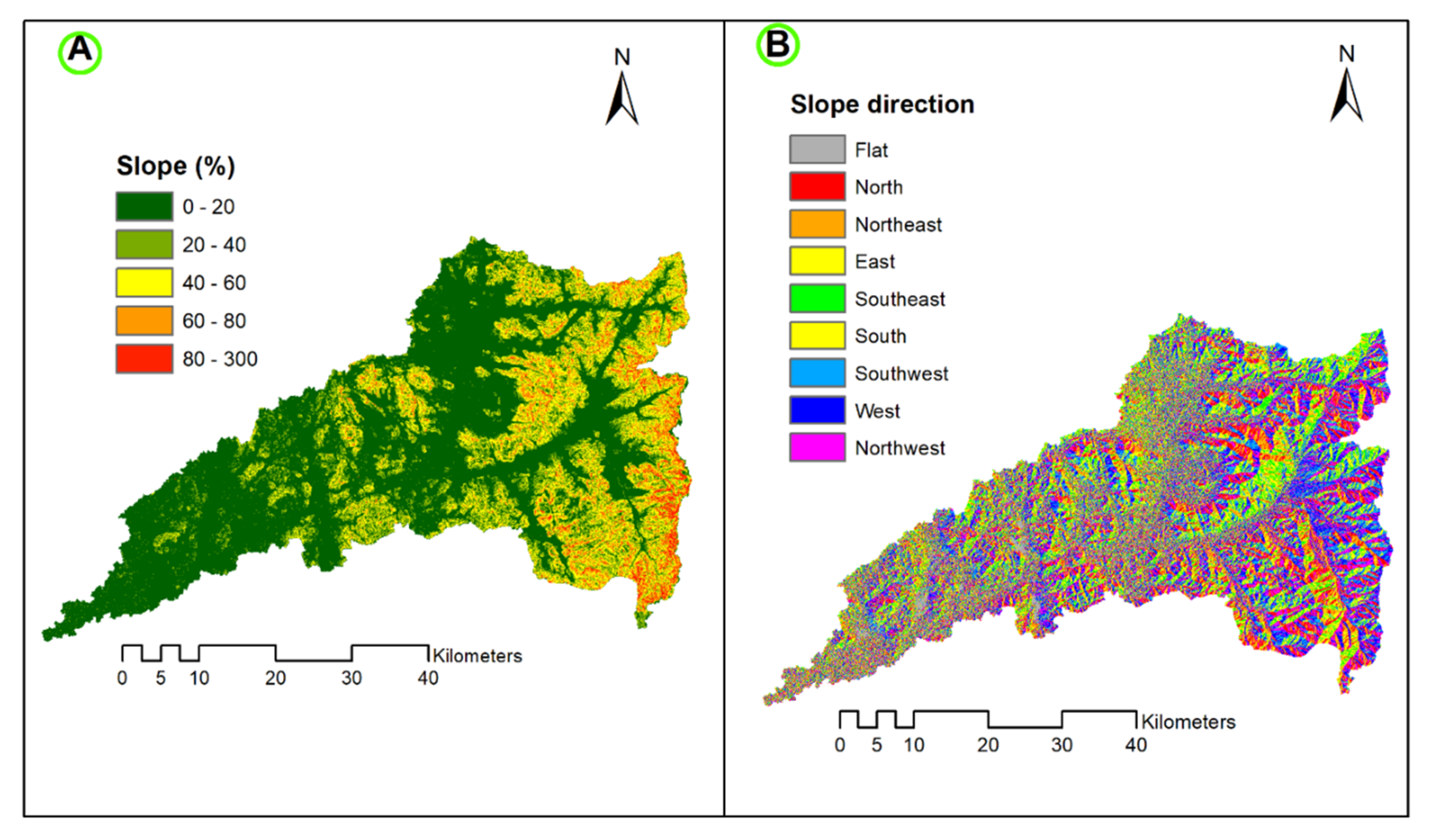


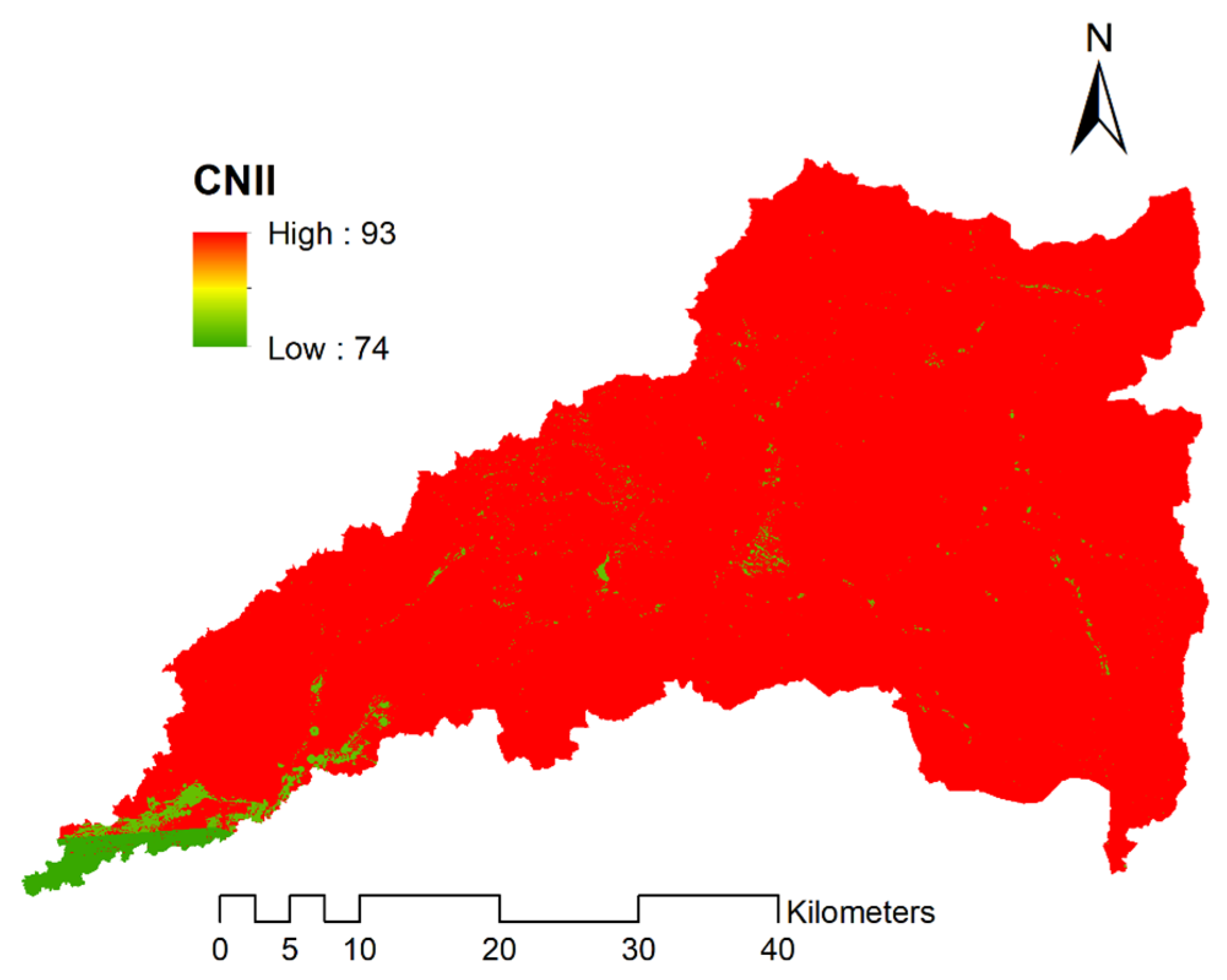


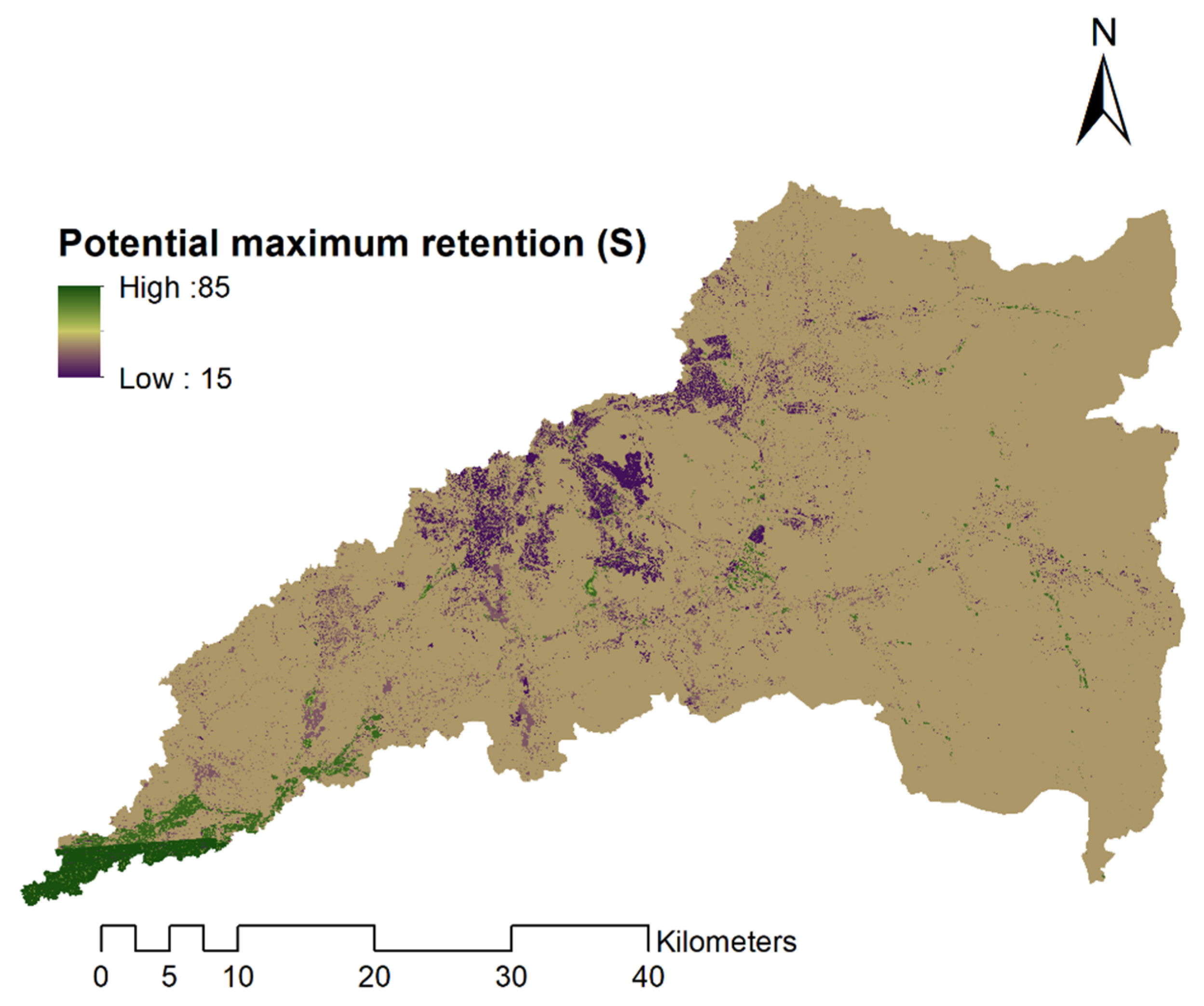

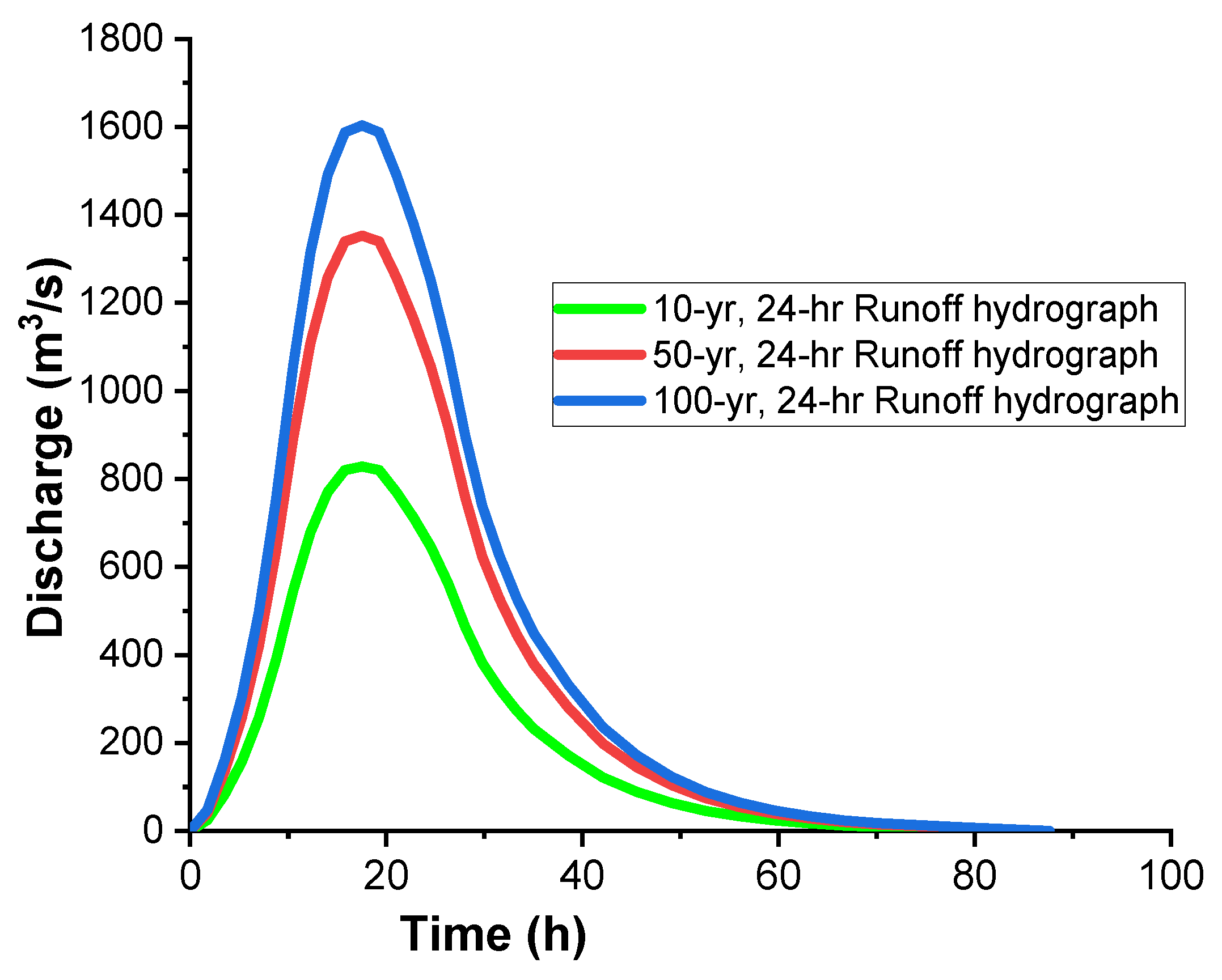
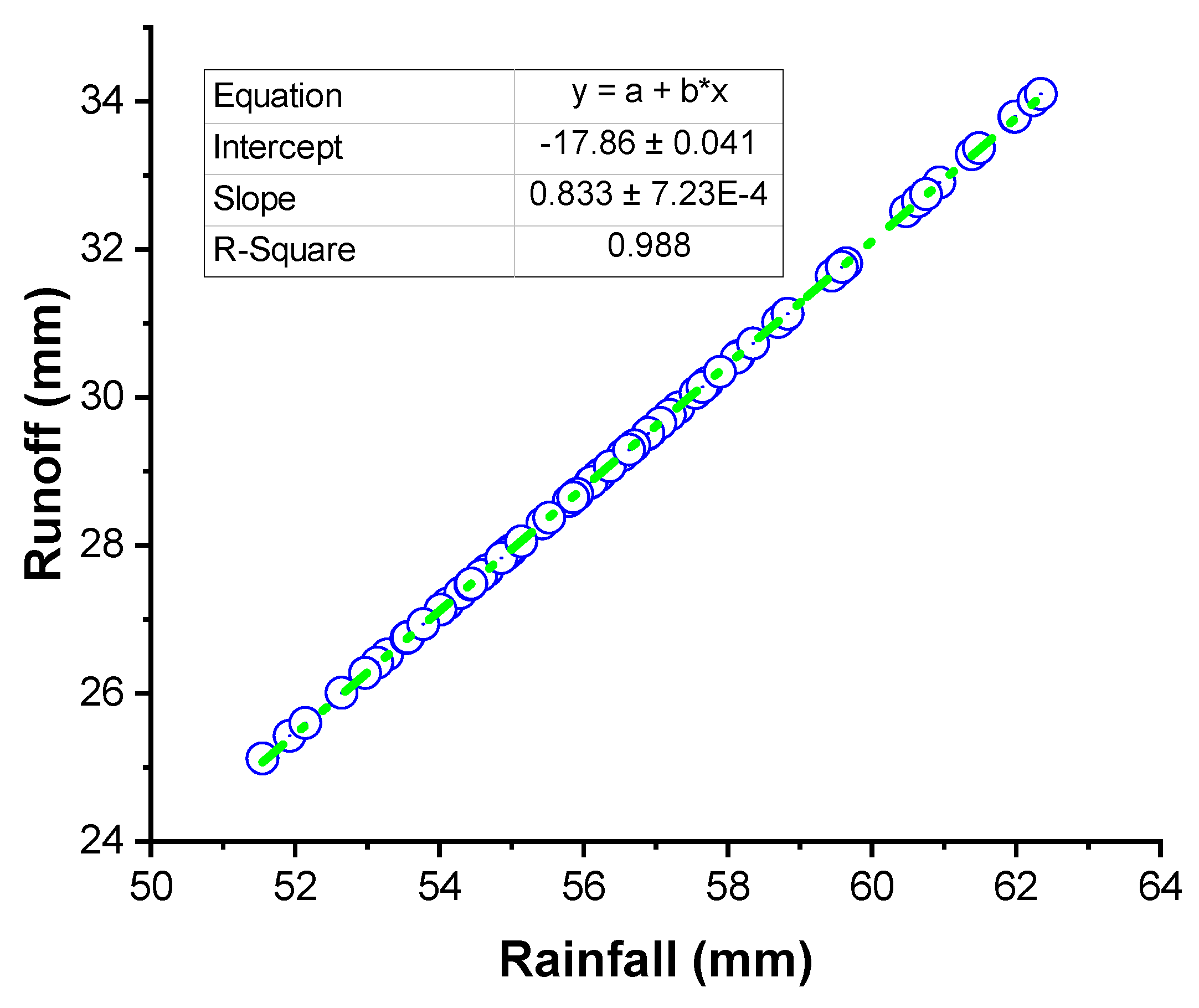
| Satellite | Sensor | Path/Row | Acquisition Date | Spatial Resolution |
|---|---|---|---|---|
| Landsat 8 | ETM | 169/45 | 3 March 2020 | 30 m |
| AMC | Curve Number | 5-Days Antecedent Rainfall (mm) | |
|---|---|---|---|
| Growing Season | Dormant Season | ||
| I | CNI | <35.6 | <12.7 |
| II | CNII | 35.6–53.3 | 12.7–27.9 |
| III | CNIII | >53.3 | >27.9 |
© 2020 by the authors. Licensee MDPI, Basel, Switzerland. This article is an open access article distributed under the terms and conditions of the Creative Commons Attribution (CC BY) license (http://creativecommons.org/licenses/by/4.0/).
Share and Cite
Al-Ghobari, H.; Dewidar, A.; Alataway, A. Estimation of Surface Water Runoff for a Semi-Arid Area Using RS and GIS-Based SCS-CN Method. Water 2020, 12, 1924. https://doi.org/10.3390/w12071924
Al-Ghobari H, Dewidar A, Alataway A. Estimation of Surface Water Runoff for a Semi-Arid Area Using RS and GIS-Based SCS-CN Method. Water. 2020; 12(7):1924. https://doi.org/10.3390/w12071924
Chicago/Turabian StyleAl-Ghobari, Hussein, Ahmed Dewidar, and Abed Alataway. 2020. "Estimation of Surface Water Runoff for a Semi-Arid Area Using RS and GIS-Based SCS-CN Method" Water 12, no. 7: 1924. https://doi.org/10.3390/w12071924





